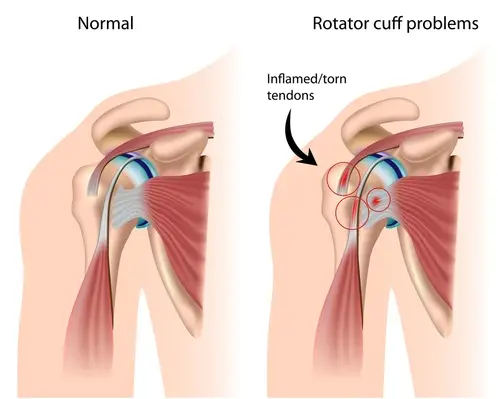What Does Rotator Cuff Pain Feel Like?
When you have rotator cuff pain, you don’t feel like doing much. Even simple tasks can be such an overwhelming chore. As a result, most rehabilitation programs are challenging, to say the least. And the harder they are, the less likely you are to stick with them to be able to get them to work for you.

Rotator Cuff Pain Common Causes
What most experience as “shoulder pain” is actually rotator cuff pain? The rotator cuff is comprised of four muscle groups and their tendons that are commonly rather weak in comparison to most muscles. The purpose of the rotator cuff is the stability of the shoulder. Weak rotator cuffs mean unstable shoulders, which in turn lead to injuries. This doesn’t have to be from a single burst of effort. In fact, most rotator cuff problems occur from repetitive activities. Such activities include tennis, baseball, volleyball, football, swimming, and boxing to name just a few. Weightlifters can experience rotator cuff pain as well if demonstrating a poor lifting technique or due to an imbalanced lifting routine.
Injuries like this can become more common due to muscular imbalances, caused by activity or merely poor posture. The posture you sleep in is also included as laying on your arm or shoulder may pinch off a nerve.
The rotator cuff is used, at least in part, during any rotational motion of the arm as a whole. Although that includes most of the motions you make, it doesn’t mean that a rotator cuff tear or injury will make it so you can’t use your arm at all. Since the muscles of the rotator cuff are used in different motions, rarely will you injure more than one of them at a time. It will be described, generally, as rotator cuff pain as fewer people understand the how the individual tendons and muscles are used well enough to give a more specific description. The most common rotator cuff injury is to the supraspinatus muscle (see caption for more information).
Overexertion is one of the most common causes of rotator cuff pain. I will define overexertion, in this case, as any motion or activity that leads to a rotator cuff injury. While this can be from heavy activity, mundane movements can also lead to such injuries if a sedentary lifestyle has weakened one’s rotator cuffs. This weakness can be attributable to other factors other than just lack of activity. Age alone can cause deterioration of these muscles.
Other reasons for rotator cuff pain include tendonitis, bursitis, and arthritis. The suffix -it generally translates to inflammation of. So, in other words, these are inflammations of the tendons, bursae (sacs filled with fluid, located between the bones and tendons or the tendons and the skin), and joints, respectively. Ironically enough, some of the common causes of those are also injuries or overexertion. Because of that, most rotator cuff pain can be prevented by taking the correct precautions in the first place.
Rotator Cuff Pain Treatment and Prevention
The treatment of rotator cuff pain varies slightly depending on what the pain stems from. The good news is that even some of the more extreme rotator cuff injuries can be taken care of nonsurgically.
As most rotator cuff problems stem from some sort of rotator cuff trauma, some of the same treatments apply across the board. For the initial stages of rotator cuff pain following a trauma, treat it as you would any muscle injury. The acronym RICE is used for treatment. This stands for rest, ice, compression, and elevation. Anti-inflammatory medications can also be used if necessary. This applies more if the problem is from tendonitis, bursitis, or arthritis. For bursitis, it may be necessary to remove fluid from the bursal sac. See a doctor for this.
Rotator cuff problems are often chronic as those who have suffered an injury never take care of the underlying cause. After the rotator cuff pain subsides, you should begin doing some stretches and exercises that target the rotator cuffs.
Poor flexibility is one of the primary causes of muscle injury in a non-strenuous environment. When you’re at the limits of your range of motion, your muscles tense. As you stretch the muscles begin to relax and lengthen. Limited range of motion means that your muscles will be tensed during normal activities, and you’ll likely get an unwelcome surprise sooner or later.
See: What To Do For Rotator Cuff Pain
What Does Rotator Cuff Pain Feel Like? Last Update: 29/5/2017



How can pain be reduced
Pingback: What does shoulder pain indicate? Common Conditions That Indicate Shoulder Blade Pain - Body Pain Tips
Pingback: What To Do For Rotator Cuff Pain? - Body Pain Tips